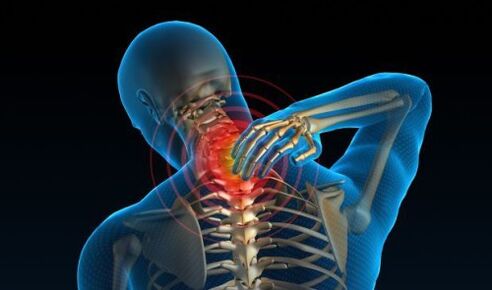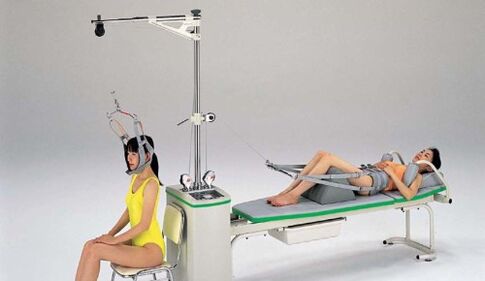Many people self-medicate because they misdiagnose themselves. Very often you hear the phrase from friends or acquaintances: I have cervical osteochondrosis. However, not all people really understand what cervical osteochondrosis is. However, not every neck grind should be considered a disease.

Cervical osteochondrosis is a disease associated with damage to the articular cartilage and bone tissue in the cervical spine.
Cervical osteochondrosis is a disease associated with damage to the articular cartilage and bone tissue in the cervical spine.
Modern doctors believe that this disease is degenerative-dystrophic in nature, as it is manifested by deformation of the intervertebral discs, their separation and a change in height.
Very often accompanied cervical osteochondrosis - vegetative-vascular dystonia (VVD). To understand where these friendly neighbors came from, let's consider the reasons why cervical osteochondrosis is manifested.
causes of the disease
Common causes of this problem:
- segmental circulatory disorders;
- various injuries;
- individual predisposition;
- high age.
Also, the causes of this disease lie in the sedentary lifestyle of modern people. >Not infrequently, the occurrence of cervical osteochondrosis is preceded by hypothermia and overeating. However, the most common causes of this disease are poor desk posture and acquired scoliosis.

Cervical osteochondrosis develops due to a decrease in the depreciation of the intervertebral disc, as well as a violation of the fibrous ring.
How are cervical migraines manifested?
Cervical osteochondrosis has a special symptomatology. Signs of such a disease are always:
- tearing, cutting and sometimes pressing pains in the back of the head, neck, shoulder;
- sensory disturbances in the affected area;
- hand numbness;
- sharp vision;
- constant tinnitus;
- pain in the region of the heart.
But even if all these symptoms are inherent in a particular person, you should not jump to conclusions, but be sure to consult a doctor after making the appropriate diagnosis.
Methods for detecting diseases
Diagnosis of cervical osteochondrosis is carried out using magnetic resonance, computed tomography, radiography.
Diagnostics using tomography makes it possible to identify disorders such as cartilage formation disorders, to assess the condition of paravertebral muscles, joints and intervertebral discs.

X-ray diagnostics contributes to the correct diagnosis, since the picture accurately reflects the type, as well as the degree of damage to a particular area.
Diagnosis of such a disease also includes duplex scanning of blood vessels, which allows to assess the condition of the arteries passing through the neck region.
What is a dangerous disease
Osteochondrosis of the neck region is fraught with unpleasant consequences. With osteochondrosis of the 1st degree, the following consequences occur:
- Dizziness;
- blurred vision or poor vision;
- Hypertension;
- loss of consciousness.
Second-degree cervical osteochondrosis is always accompanied by vegetative-vascular dystonia (VVD). This disease is manifested by severe headaches due to lack of oxygen in the brain. Also, VVD is manifested by difficulty breathing, anxiety attacks, numbness in the palms and feet, lack of sleep, fatigue, increased irritability. In addition, the consequences may not be foreseeable. For example, patients can lose their eyesight completely.

VVD and cervical osteochondrosis have similar symptoms. Therefore, the methods of treating VVD and cervical osteochondrosis are very similar.
treatment methods
There are several ways to heal the consequences of osteochondrosis of the cervical region, as well as VSD.
- Medical therapy.
- alternative treatment.
- Physical therapy.
Medical treatment
This therapy for both cervical osteochondrosis and VVD includes the use of painkillers, nonsteroidal anti-inflammatory drugs, myotropic antispasmodics, steroid drugs and chondroprotectors.
Painkillers help cure the disease by eliminating spasms. With such ailments, you can use warming ointments and gels.
Thanks to nonsteroidal anti-inflammatory drugs, such diseases can be cured by eliminating swelling and inflammation.
Chondroprotectors help heal cervical osteochondrosis due to chondroetin and glucosamine, which are part of these drugs.
alternative therapy
This type of treatment includes a complex of physiotherapeutic procedures aimed at eliminating pain, inflammation and restoring the body as a whole.

Thanks to magnetic therapy, osteochondrosis can be cured by exposure to a magnetic field directed to the affected area.
With the help of electrotherapy, you can quickly and permanently heal from a cervical migraine. This is made possible by increased blood circulation, which is promoted by electric current.
You can also eliminate pain and inflammation in cervical migraines with the help of sound waves. This treatment is called shock wave therapy.
Thanks to the power of healing mud, you can save yourself from VVD and cervical migraines. Mud soaked in mineral water reduces swelling, relaxes muscles and eliminates pain. The name of this treatment is balneotherapy.
physical therapy

Such therapy involves a special complex of physical activity, including swimming, walking in the fresh air and simple physical exercises. This complex can be performed by both children and the elderly. By implementing all the recommendations, you can get rid of VVD and cervical migraines, effectively and quickly eliminating their consequences.





















